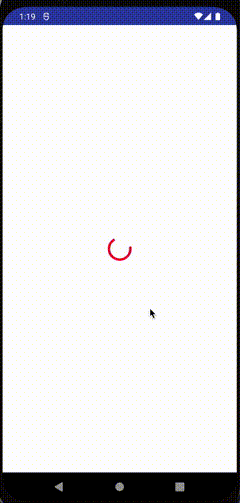FlowReduxStateMachine Basics: State and Action¶
FlowRedux provides a convenient DSL to describe your state machine. This page introduces and explains step by step the FlowRedux DSL.
Let’s build an example app using FlowRedux: This app loads a list of items from a web service. As we introduce more concepts of the DSL we will extend this example with more features.
This page is meant to be read from top to bottom.
FlowReduxStateMachine¶
The base class in FlowRedux is FlowReduxStateMachine.
It has a very simple public API:
class FlowReduxStateMachine<State, Action> {
val state : Flow<State>
suspend fun dispatch(action : Action)
}
Every FlowReduxStateMachine works on a State class.
How you model your state is up to you and depends on what your app and business logic actually has as requirements.
You can collect the FlowReduxStateMachine.state : Flow<State> (from Kotlin coroutines library) by calling .collect() on it.
Whenever the state of the state machine changes, observers get the updated state via this Flow.
We also need a way to “input” something to our state machine like a user has clicked on a button in the UI.
“Inputs” are called Actions in FlowRedux.
An example is data class LoginSubmittedAction(val username : String, val password : String).
Again, how you model your Actions is up to you.
There are no constraints or limitations from FlowRedux.
You can dispatch an Action with FlowReduxStateMachine.dispatch(action).
That should be enough information to get started with our example app based on FlowRedux.
Let’s define the Statesfor our state machine.
As said before we load a list of items from a web server (via http) and display that list.
While loading the list we show a loading indicator on the screen and if an error occurs we show an error message on the screen with a retry button.
This gives us the following states:
sealed interface ListState {
// Shows a loading indicator on screen
object Loading : ListState
// List of items loaded successfully, show it on screen
data class ShowContent(val items: List<Item>) : ListState
// Error while loading happened
data class Error(val message: String) : ListState
}
If the state machine reaches the Error state then we display an error message in our UI but also a button the users of our app can click to retry loading the items.
This gives us the following Actions:
sealed interface Action {
object RetryLoadingAction : Action
}
This is how the UI looks like:

Initial State¶
Every FlowReduxStateMachine needs an initial state.
This specifies in which state the state machine starts.
In our example we start with the Loading state.
class ItemListStateMachine(
private val httpClient: HttpClient
) : FlowReduxStateMachine<ListState, Action>(initialState = Loading) {
init {
spec {
// will be filled in next section
...
}
}
}
In FlowRedux we need an init {...} block containing a spec { ... } block inside.
The spec { ... } block is actually where we write our state machine specification with the DSL.